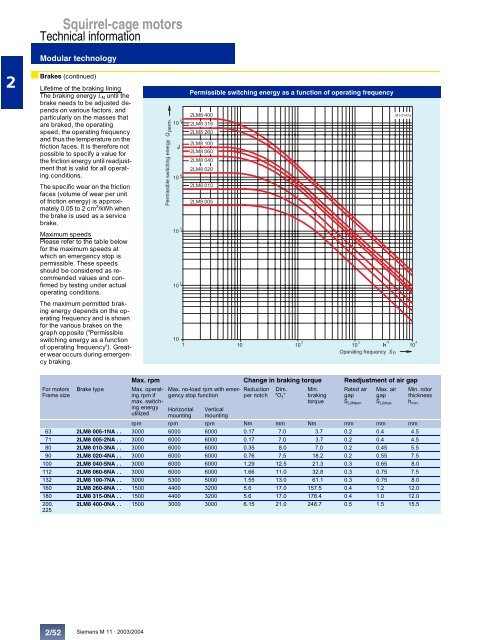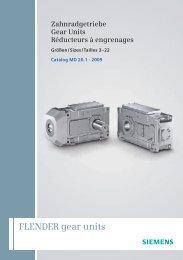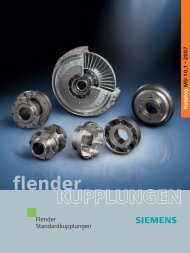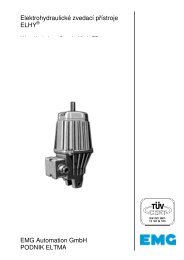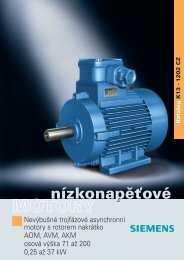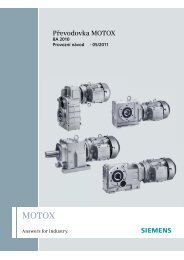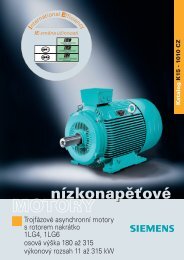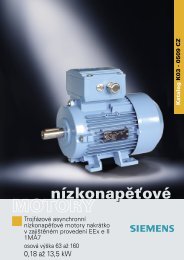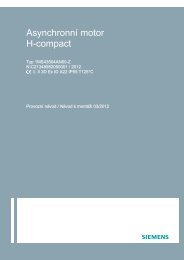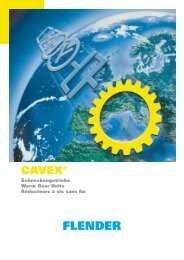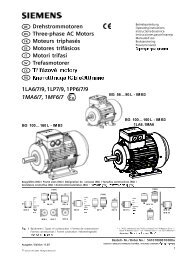low-voltage
low-voltage
low-voltage
- No tags were found...
Create successful ePaper yourself
Turn your PDF publications into a flip-book with our unique Google optimized e-Paper software.
Squirrel-cage motors<br />
Technical information<br />
Modular technology<br />
2<br />
■ Brakes (continued)<br />
Lifetime of the braking lining<br />
The braking energy L N until the<br />
brake needs to be adjusted depends<br />
on various factors, and<br />
particularly on the masses that<br />
are braked, the operating<br />
speed, the operating frequency<br />
and thus the temperature on the<br />
friction faces. It is therefore not<br />
possible to specify a value for<br />
the friction energy until readjustment<br />
that is valid for all operating<br />
conditions.<br />
The specific wear on the friction<br />
faces (volume of wear per unit<br />
of friction energy) is approximately<br />
0.05 to 2 cm 3 /kWh when<br />
the brake is used as a service<br />
brake.<br />
Maximum speeds<br />
Please refer to the table be<strong>low</strong><br />
for the maximum speeds at<br />
which an emergency stop is<br />
permissible. These speeds<br />
should be considered as recommended<br />
values and confirmed<br />
by testing under actual<br />
operating conditions.<br />
The maximum permitted braking<br />
energy depends on the operating<br />
frequency and is shown<br />
for the various brakes on the<br />
graph opposite ("Permissible<br />
switching energy as a function<br />
of operating frequency"). Greater<br />
wear occurs during emergency<br />
braking.<br />
2 A H EI I E> A I M EJ D E C A A HC O 3 F A H <br />
<br />
<br />
<br />
<br />
<br />
#<br />
"<br />
!<br />
Permissible switching energy as a function of operating frequency<br />
& " <br />
& ! #<br />
& $ <br />
& <br />
& $ <br />
& " <br />
& <br />
& <br />
& #<br />
# " % =<br />
<br />
<br />
<br />
<br />
!<br />
F A H= JE C BHA G K A O 5 <br />
D <br />
"<br />
For motors<br />
Frame size<br />
Brake type<br />
Max. rpm Change in braking torque Readjustment of air gap<br />
Max. operating<br />
rpm if<br />
max. switching<br />
energy<br />
utilized<br />
Max. no-load rpm with emergency<br />
stop function<br />
Horizontal<br />
mounting<br />
Vertical<br />
mounting<br />
Reduction<br />
per notch<br />
Dim.<br />
"O 1 "<br />
Min.<br />
braking<br />
torque<br />
Rated air<br />
gap<br />
S LüNenn<br />
Max. air<br />
gap<br />
S Lümax.<br />
rpm rpm rpm Nm mm Nm mm mm mm<br />
63 2LM8 005-1NA . . 3000 6000 6000 0.17 7.0 3.7 0.2 0.4 4.5<br />
71 2LM8 005-2NA . . 3000 6000 6000 0.17 7.0 3.7 0.2 0.4 4.5<br />
80 2LM8 010-3NA . . 3000 6000 6000 0.35 8.0 7.0 0.2 0.45 5.5<br />
90 2LM8 020-4NA . . 3000 6000 6000 0.76 7.5 18.2 0.2 0.55 7.5<br />
100 2LM8 040-5NA . . 3000 6000 6000 1.29 12.5 21.3 0.3 0.65 8.0<br />
112 2LM8 060-6NA . . 3000 6000 6000 1.66 11.0 32.8 0.3 0.75 7.5<br />
132 2LM8 100-7NA . . 3000 5300 5000 1.55 13.0 61.1 0.3 0.75 8.0<br />
160 2LM8 260-8NA . . 1500 4400 3200 5.6 17.0 157.5 0.4 1.2 12.0<br />
180 2LM8 315-0NA . . 1500 4400 3200 5.6 17.0 178.4 0.4 1.0 12.0<br />
200,<br />
225<br />
2LM8 400-0NA . . 1500 3000 3000 6.15 21.0 248.7 0.5 1.5 15.5<br />
Min. rotor<br />
thickness<br />
h min.<br />
2/52<br />
Siemens M 11 · 2003/2004


